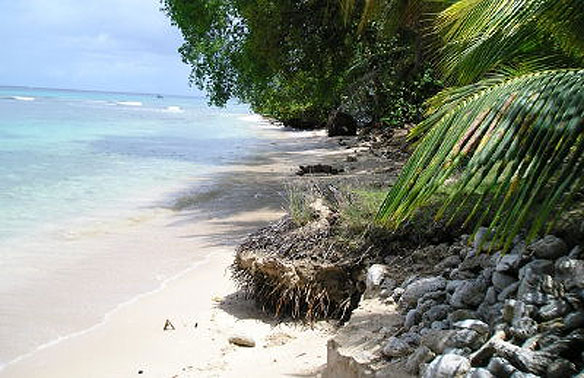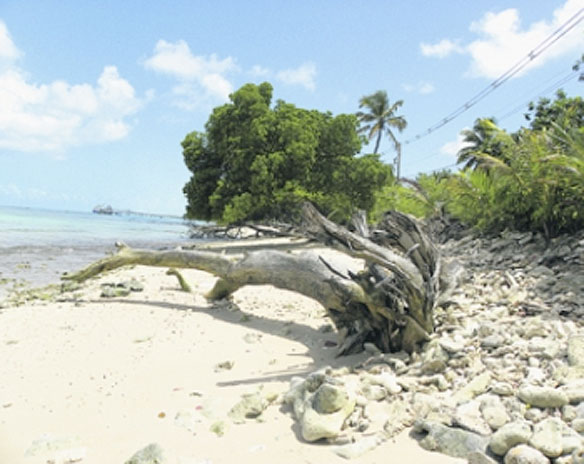
Eroding Beach, Mullins Bay. Photo Source: Barbados Free Press
Last Chance Beach, Mullins Bay, Barbados
By Peter J. Frank
Most islands in the Caribbean suffer erosion to a certain degree, much of it from natural causes. Barbados, a country dependent on tourism, knows it needs to protect its beaches, but some of its attempts to do so end up making matters worse. Local environmental activists contend that in several places along Barbados’s west shore—the famed Platinum Coast, lined with luxury hotels, condos, and expensive homes—erosion has been exacerbated by the construction of seawalls and groins.
On the island’s northwest coast, sunbathers used to be able to walk from the popular beach bar on Mullins Beach north for several miles up the sandy shore. Now, there are only impassable boulders, sea walls, and crashing surf. The author of the local Mullins Bay blog blames the construction of three stone groins at St. Peter’s Bay, a new condominium development a quarter mile north of Mullins Beach. Installed ostensibly to help build up the beach there, the structures have sapped the adjacent shoreline of sand. Surprisingly, Barbados’s Coastal Zone Management Unit, a government agency charged with controlling erosion, approved the groins. It maintains that global warming is the main culprit in the island’s erosion problem. Rising sea levels and severe storms certainly play a role, but to protect its shoreline, Barbados also needs to balance the demands of development and preservation.
Barbados Looks to Beaches as First Line of Defence, IPS
Battling Beach erosion: Barbados

Clinketts Beach, Barbados North Coast. Photo Source: Green Antilles
As surely as the coastline draws people and development, it brings on its own destruction.
On the island nation of Barbados, particularly on its developed west coast, the major problem is beach erosion. This is a serious concern anywhere, but particularly so when tourism is the country’s number one industry. The causes are complex. Tourist hotels themselves are partly to blame because over the years their owners have built structures to trap sand, which prevents its migration further down the coast to other areas.
But the most serious threat to the beaches is the loss of offshore coral reefs through pollution, primarily caused by domestic sewage. As the reefs die, they lose their ability to reduce the energy and erosive force of incoming waves.
Into this complex scenario of cause and effect stepped the IDB-financed Barbados Coastal Conservation Program. Drawing on previous studies and surveys, the program has put in place a genuinely integrated approach that over the years has combined research, pollution control and anti-erosion measures with institutional and legal mechanisms to control coastal development and prepare a national coastal zone management plan. Meanwhile, the country has made significant progress in reducing pollution with a series of sewage treatment systems and solid waste disposal plants.

Barbados, Bathsheba Surf Beach. Photo Source: Barbados Free Press









